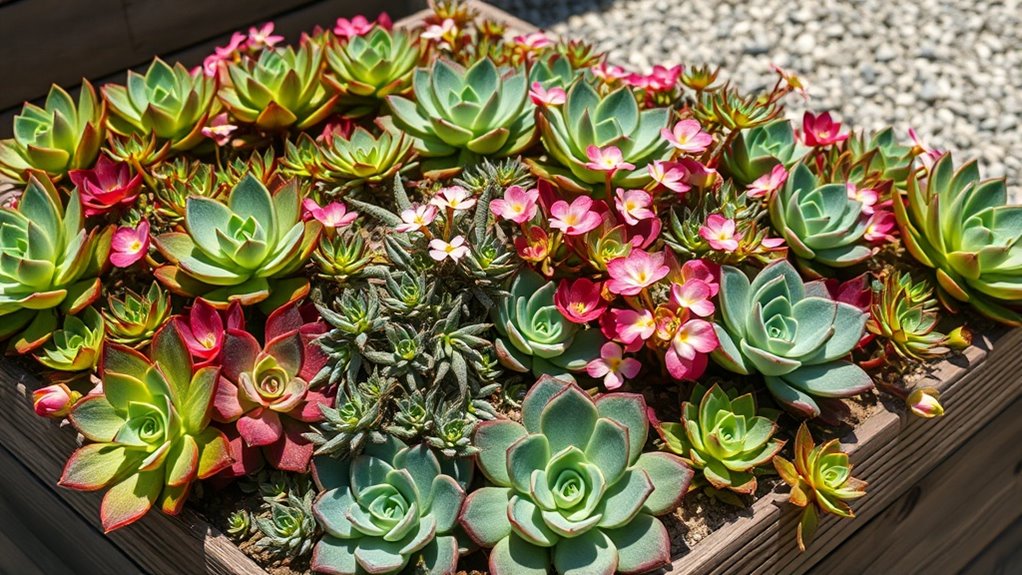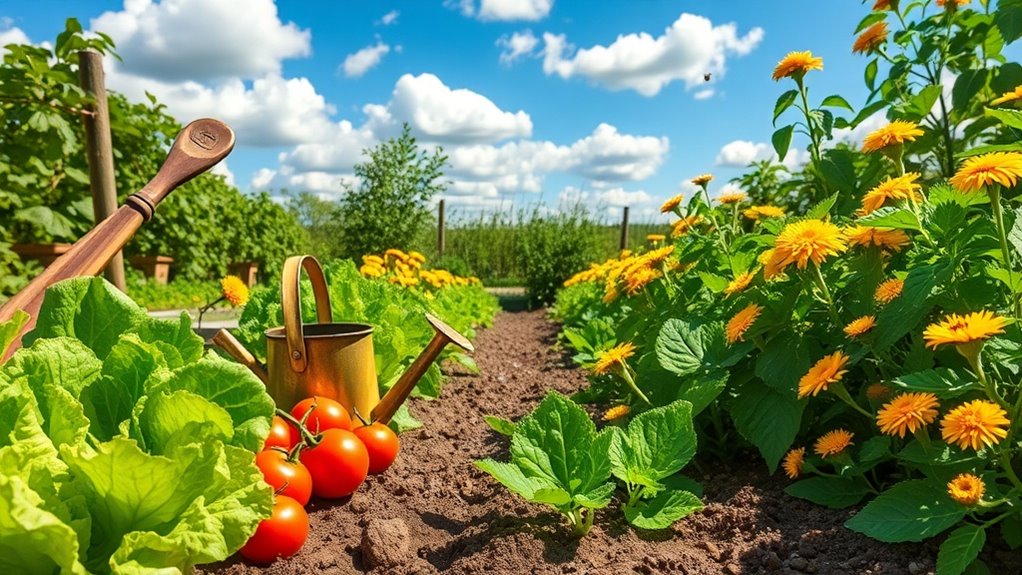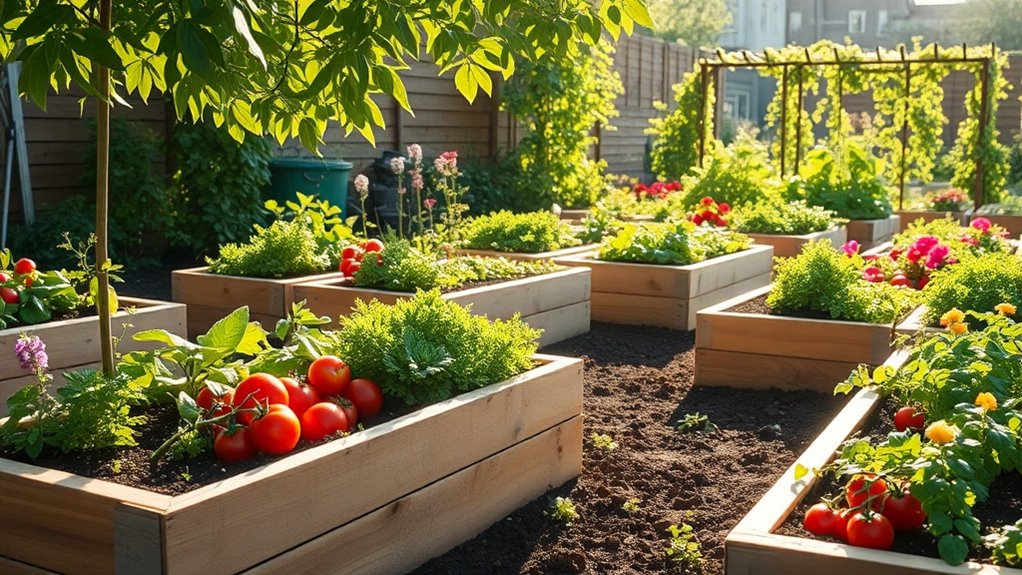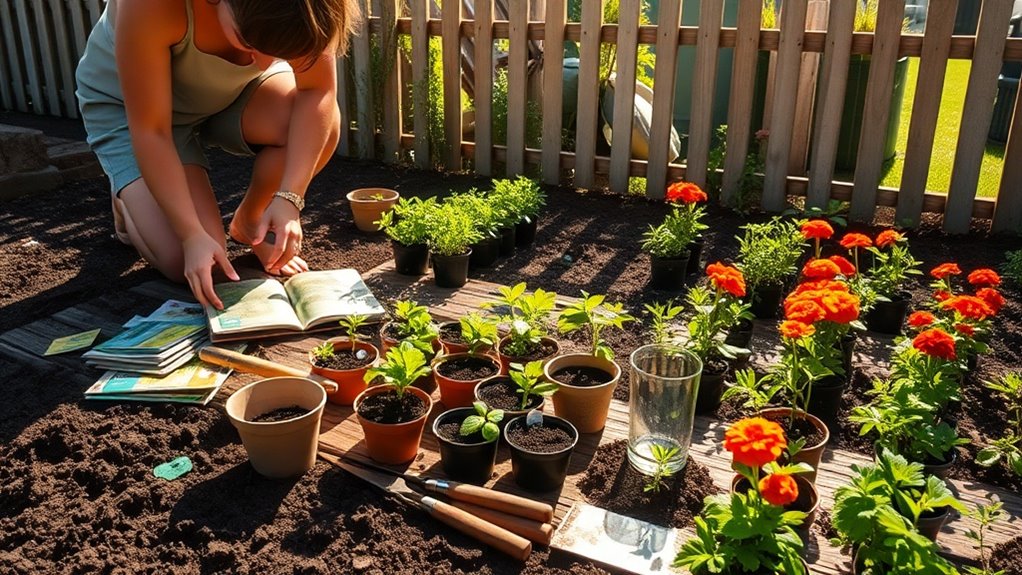7 Things You Should NEVER Do in Your Garden
Don’t overwater your plants, or you’ll risk root rot and fungal issues that harm roots. You’ll neglect soil health if you skip testing, missing vital pH and nutrient balances that boost yields. Plant in the wrong spot, and your plants won’t get proper sun or drainage, stunting growth. Ignore pests and diseases, and they’ll quickly devastate your garden—monitor them regularly. Prune incorrectly with dull tools, causing jagged cuts and plant stress. Overcrowd your space, and you’ll invite poor air flow and competition. Overuse chemical fertilizers, leading to soil imbalance and runoff problems. Master these avoids for a lush garden by exploring further tips.
Key Takeaways
- Avoid overwatering plants, as it can cause root rot and fungal growth.
- Never neglect soil health; regularly test pH and address nutrient deficiencies.
- Do not plant in the wrong location, as it can stunt growth and invite diseases.
- Ignore pest and disease control at your peril; monitor regularly to prevent infestations.
- Refrain from overcrowding your garden, which leads to poor air circulation and competition for resources.
Overwater Your Plants
While it’s tempting to give your plants extra water, overwatering can quickly damage their roots. This ranks among the most common gardening errors, causing root rot, fungal growth, and wilting leaves that you might mistake for thirst. Additionally, if overwatering does occur, implementing recovery techniques can help restore your plant’s health.
You’re better off checking soil moisture with your finger—if it’s damp, hold off. Use well-draining pots and water only when needed to avoid drowning roots and wasting resources.
By recognizing signs of overwatering, you can maintain healthier plants and prevent long-term damage.
Neglect Soil Health
You shouldn’t neglect your soil’s health, as it directly impacts your plants’ growth and yields.
Ignoring pH balance disrupts nutrient uptake, leaving your garden vulnerable to poor performance.
Skipping soil testing prevents you from making informed adjustments, so always check and correct soil conditions first.
For optimal results, consider soil testing to identify and remedy potential garden problems early.
Additionally, soil testing can increase crop yields by ensuring your soil provides the necessary nutrients for robust plant development.
Ignore Ph Balance
Neglecting your soil’s pH balance disrupts nutrient uptake, stunting plant growth and inviting diseases that could devastate your garden.
You’ll notice yellowing leaves or poor yields as plants struggle in acidic or alkaline conditions.
Don’t overlook how pH affects root health; it locks up essential nutrients like iron or phosphorus, weakening your crops.
Adjust soil with lime for acidity or sulfur for alkalinity to keep things optimal.
Skip Soil Testing
Overlooking soil testing mirrors the risks of ignoring pH, as it leaves you unaware of nutrient deficiencies, toxins, or improper textures in your soil.
Without testing, you’ll plant blindly, risking poor growth from imbalanced nutrients or compacted earth that hinders root development. You might waste money on unnecessary fertilizers or amendments that don’t address real issues, leading to stunted plants and failed harvests.
Instead, test your soil annually—it’s quick and affordable through local labs. This empowers you to make informed choices, like adding lime for acidity or organic matter for better drainage, ensuring a thriving garden.
Plant in the Wrong Location
One critical mistake in gardening is planting in the wrong location, which can stunt growth and invite diseases.
You’ll compromise your plants’ health if you ignore their sunlight needs—shade-lovers wilt in full sun, while sun-worshippers fade in dim spots.
Check soil drainage too; boggy areas drown roots, and dry spots parch them.
Measure your space carefully to avoid overcrowding, which blocks air flow and nutrients.
Before planting, research each plant’s requirements and test your site’s conditions.
To enhance your gardening success, implement universal soil prep methods.
This simple step ensures thriving gardens and saves you time and effort.
To build a strong foundation for your plants, always prioritize soil preparation before planting.
Ignore Pest and Disease Control
Pests and diseases can devastate your garden if you skip control efforts.
You’ll end up with stunted growth, wilting plants, and total crop loss, turning your oasis into a wasteland.
Don’t wait for problems to escalate—act proactively to protect your investment.
Incorporate natural staples from your kitchen to enhance your pest control strategies.
-
Monitor regularly: Check plants weekly for pests like aphids or signs of disease such as spots or wilting.
-
Identify early: Learn to spot issues before they spread, using simple tools like magnifying glasses.
-
Apply controls: Use targeted, eco-friendly methods, like neem oil, to manage outbreaks effectively.
-
Maintain hygiene: Remove infected debris promptly to prevent recurrence and promote healthy growth.
Additionally, implement natural DIY techniques to create a pest-free garden without any financial costs.
Prune Incorrectly
You risk damaging your plants if you prune them at the wrong time, like during peak growth.
You’ll weaken your garden by over-pruning branches, which removes too much foliage and stresses the plant.
Make sure you don’t use dull tools, as they create messy cuts that can lead to infections. In contrast, proper pruning can result in a 50% yield increase for tomato plants.
Instead, always incorporate a straightforward methodology to improve your pruning techniques effectively.
Wrong Pruning Time
Pruning at the wrong time can severely stress your plants, making them vulnerable to disease or poor growth.
You’ll disrupt natural cycles, like cutting back summer bloomers in spring, which removes essential buds and weakens recovery. Timing matters for health, so always align with seasonal rhythms.
-
Ignore plant cycles: Pruning during active growth invites pests and disease.
-
Overlook weather: Cutting in extreme heat or frost damages tissues instantly.
-
Neglect species needs: Evergreens suffer from winter pruning, losing protective foliage.
-
Skip research: Not checking optimal times leads to stunted development.
Stay informed to protect your garden’s vitality.
Over-Prune Branches
Overzealous branch removal can weaken your plants’ health and vitality. When you over-prune, you strip away essential leaves, reducing photosynthesis and exposing the plant to pests or diseases. This disrupts growth and recovery, leaving you with stressed, unproductive greenery.
To help you avoid these errors, here’s a practical comparison:
| Over-Pruning Mistake | Why It Harms Your Plants |
|---|---|
| Removing more than 25% at once | Weakens structure and invites pests |
| Cutting back to bare wood | Slows regrowth and causes dieback |
| Ignoring the plant’s maturity | Leads to irreversible damage |
| Focusing only on aesthetics | Compromises overall health |
| Pruning without a clear plan | Results in uneven, weak branches |
Balance your cuts to keep plants thriving.
Use Dull Tools
While over-pruning can stress your plants, wielding dull tools during pruning compounds the damage by tearing stems instead of making clean cuts. This creates entry points for pests and diseases, slows healing, and weakens your garden’s overall health.
You’ll end up with ragged wounds that invite trouble, so always prioritize sharp tools for precise work.
-
Torn stems attract diseases: Jagged cuts expose inner tissues, making infections more likely.
-
Healing takes longer: Plants struggle to seal wounds, leaving them vulnerable.
-
Increases plant stress: Poor cuts add to the burden from other issues.
-
Wastes your effort: Dull tools require more force, leading to sloppy results and frustration.
Overcrowd Your Garden
One sure way to stunt your garden’s growth is crowding plants too closely together. This creates fierce competition for sunlight, water, and nutrients, leaving your plants weak and prone to diseases or pests. According to gardening resources, beginner mistakes such as this can significantly impact overall garden success.
You’ll notice poor air circulation, which invites fungal issues, and makes weeding or harvesting a chore. Instead, check each plant’s spacing requirements on labels or packets before planting.
Thin seedlings promptly if they’re too dense, giving roots ample room to spread. By doing so, you promote vigorous growth, higher yields, and a healthier garden overall. Overcrowding is one of the common gardening mistakes that can lead to disappointing results for beginners.
Use Chemical Fertilizers Excessively
Overusing chemical fertilizers throws your garden’s soil out of balance, leading to nutrient burn and weakened plant roots.
This disrupts the ecosystem, harming your plants’ long-term health and the environment. Don’t ignore these risks; instead, adopt smarter practices to maintain a thriving garden.
-
You’ll leach essential nutrients from the soil, reducing fertility.
-
Your plants may suffer from salt buildup, stunting growth.
-
Chemical runoff pollutes waterways, affecting wildlife and water quality.
-
You’ll foster pest resistance, making future control harder.





